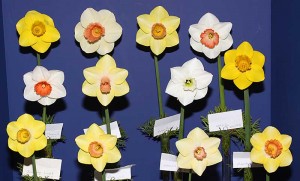The ADS Handbook says if one bloom in a collection scores below 90 points, then the collection cannot receive a blue ribbon. That also means it can’t win the ADS award. After eliminating collections that have blooms below 90 points, you then judge the remaining collections.
“In judging collections of high quality, judges will need to look at the overall quality of the blooms in the competing collections, and may sometimes have to point score to determine the winner of the blue ribbon. The collection with the highest level of quality is given the blue ribbon.”
In practice we cannot score all the flowers on the scale from 0 to 100. What we can do is use the technique common in overseas daffodil shows. This was first demonstrated to me by Reg Nicholl. I have explained it at a judging school, demonstrated it to student judges at our local shows, and used it this year with other accredited judges. In brief, you pick a reasonable good flower in one of the competing collections and assign it an arbitrary score between 0 and 10. You then compare all the blooms in all the competing collections against it and assign scores as follows. If it is a little better or a little worse than the reference bloom, give it a score 1 higher or 1 lower as warranted. If two blooms look comparable in beauty, give them the same score. If you find a bloom that look half way between, say, 7 and 8, give it 7.5. Don’t make the score finer than a half point. It is much faster to “point score” blooms on the compressed scale of 0 to 10 than on the full scale of 0 to 100. The trouble with using the full scale is that you spend too much time debating whether to deduct one or two points for a nick.
Here is an example of two collections that my panel judged this year. In the first collection our scores were 7.0 5.5 7.5 7.5 7.0 7.5 7.5 8.0 6.5 6.5 7.5 7.0 total 85
In the second collection our scores were
6.0 7.0 7.5 6.5 6.0 8.5 6.0 7.5 7.5 6.5 7.0 6.5 total 81
This pictures are a little over exposed, and you can’t see some of the details we were able to see by picking up the test tubes to view the backs of the flowers. Nevertheless, this should give you the idea of how to judge collections without taking an inordinate amount of time. As I mentioned, I demonstrated this technique to students judges a few year ago at Murphys when we were confronted with three worthy collections. I don’t recall whether they were Bozievich or Throckmorton collections, but it was not clear from an overall glance which should be the winner since a collection with a lot of good flowers also had one or two that were not so good. I allowed the students to assign the scores, and in the end they were confident that they had indeed picked the collection with the highest level of quality to received the blue ribbon.
Kirby Fong



Thank you Kirby. A nice exposition. Harold
Dear Kirby, Bob Spotts taught me this technique a couple years ago. I think it is a reasonable way to chose between two strong collections. Thank you so much for posting this illustrated explanation of this procedure.
Deb, in Newport Oregon, where the rhododendrums are opening and great birds are still stopping as they migrate.
Deb Holland Newport, Oregon
Daffodil Friends,
The process of judging collections and using the method described by Kirby is presented in The Daffodil Journal, September and December 2004 issues.
I have been forced, in the past, to award an ADS ribbon to a collection that I felt was not the best one. It was because of that worst flower method of judging. I disliked it and even apologised to the exhibitor for having to do it. This method is fair to all, and does not breach the handbook rules. Thanks for spelling it out.
It may be time for addition to the Handbook of a section that basically repeats Kirby’s fine exposition of a rational method for judging collections. Melissa
At 09:27 PM 4/29/2010, Kirby Fong wrote:
Kirby,
Is there any method to selecting the bloom that is used at the standard? Do you look for a flower that is probably not a ten so you have some room to go above as well as below it in score?
I like this method and I can see how it would dismiss (for better or worse–in some cases) any regard for meticulous staging, which ADS says it does not give credit for. It all you are scoring is the flower itself on an individual basis, then the overall appearance of the group would have no bearing in the decision.
Having said that, if given the opportunity, I would favor a fixed number of points for staging, which I think should be part of this game we play. Chriss
—
Dear Bob,
The two collections that Kirby used as examples were not Bozievichs or even ADS collections.
They were the two entries in the ODS (Oregon Daffodil Society) ’12’ Challenge, offered at the 2010 Albany Show. Twelve different cultivars, one stem each. The exhibitor must be the hybridizer but need not be the grower. Hybridizer: Person who collects or supervises the collection of daffodil seed from which a new cultivar is produced. Each stem must score 90 points or more. Identification to be concealed until after judging.
The hybridizers were Elise Havens and David Jackson. The Jacksons stayed with Elise after Murphys and judged with us at the Albany show. It was a delight.
I think that both collections were really beautiful, but I can understand how you might consider the choices a bit odd for a Bozievich.
Deb Holland, Newport, Oregon